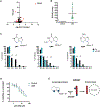The Novel Glutamine Antagonist Prodrug JHU395 Has Antitumor Activity in Malignant Peripheral Nerve Sheath Tumor
- PMID: 31594823
- PMCID: PMC7007868
- DOI: 10.1158/1535-7163.MCT-19-0319
The Novel Glutamine Antagonist Prodrug JHU395 Has Antitumor Activity in Malignant Peripheral Nerve Sheath Tumor
Abstract
The carbon and nitrogen components of glutamine are used for multiple biosynthetic processes by tumors. Glutamine metabolism and the therapeutic potential of glutamine antagonists (GA), however, are incompletely understood in malignant peripheral nerve sheath tumor (MPNST), an aggressive soft tissue sarcoma observed in patients with neurofibromatosis type I. We investigated glutamine dependence of MPNST using JHU395, a novel orally bioavailable GA prodrug designed to circulate inert in plasma, but permeate and release active GA within target tissues. Human MPNST cells, compared with Schwann cells derived from healthy peripheral nerve, were selectively susceptible to both glutamine deprivation and GA dose-dependent growth inhibition. In vivo, orally administered JHU395 delivered active GA to tumors with over 2-fold higher tumor-to-plasma exposure, and significantly inhibited tumor growth in a murine flank MPNST model without observed toxicity. Global metabolomics studies and stable isotope-labeled flux analyses in tumors identified multiple glutamine-dependent metabolites affected, including prominent effects on purine synthesis. These data demonstrate that glutamine antagonism is a potential antitumor strategy for MPNST.
©2019 American Association for Cancer Research.
Conflict of interest statement
Figures






Similar articles
-
Pro-905, a Novel Purine Antimetabolite, Combines with Glutamine Amidotransferase Inhibition to Suppress Growth of Malignant Peripheral Nerve Sheath Tumor.Mol Cancer Ther. 2023 Dec 1;22(12):1390-1403. doi: 10.1158/1535-7163.MCT-23-0258. Mol Cancer Ther. 2023. PMID: 37616542 Free PMC article.
-
Antitumor effects of 4-methylumbelliferone, a hyaluronan synthesis inhibitor, on malignant peripheral nerve sheath tumor.Int J Cancer. 2017 Jan 15;140(2):469-479. doi: 10.1002/ijc.30460. Epub 2016 Oct 18. Int J Cancer. 2017. PMID: 27706810
-
Novel Glutamine Antagonist JHU395 Suppresses MYC-Driven Medulloblastoma Growth and Induces Apoptosis.J Neuropathol Exp Neurol. 2021 Mar 22;80(4):336-344. doi: 10.1093/jnen/nlab018. J Neuropathol Exp Neurol. 2021. PMID: 33712838 Free PMC article.
-
Malignant Peripheral Nerve Sheath Tumors.Adv Exp Med Biol. 2016;916:495-530. doi: 10.1007/978-3-319-30654-4_22. Adv Exp Med Biol. 2016. PMID: 27165368 Review.
-
Malignant Peripheral Nerve Sheath Tumor.Surg Oncol Clin N Am. 2016 Oct;25(4):789-802. doi: 10.1016/j.soc.2016.05.009. Surg Oncol Clin N Am. 2016. PMID: 27591499 Review.
Cited by
-
From Genes to -Omics: The Evolving Molecular Landscape of Malignant Peripheral Nerve Sheath Tumor.Genes (Basel). 2020 Jun 24;11(6):691. doi: 10.3390/genes11060691. Genes (Basel). 2020. PMID: 32599735 Free PMC article. Review.
-
A Sequencing Overview of Malignant Peripheral Nerve Sheath Tumors: Findings and Implications for Treatment.Cancers (Basel). 2025 Jan 8;17(2):180. doi: 10.3390/cancers17020180. Cancers (Basel). 2025. PMID: 39857962 Free PMC article. Review.
-
Screening in serum-derived medium reveals differential response to compounds targeting metabolism.Cell Chem Biol. 2023 Sep 21;30(9):1156-1168.e7. doi: 10.1016/j.chembiol.2023.08.007. Epub 2023 Sep 8. Cell Chem Biol. 2023. PMID: 37689063 Free PMC article.
-
Exploring the metabolic signaling network of GFPT in cancer.Cell Death Discov. 2025 Aug 19;11(1):388. doi: 10.1038/s41420-025-02687-3. Cell Death Discov. 2025. PMID: 40830088 Free PMC article. Review.
-
Discovery of DRP-104, a tumor-targeted metabolic inhibitor prodrug.Sci Adv. 2022 Nov 18;8(46):eabq5925. doi: 10.1126/sciadv.abq5925. Epub 2022 Nov 16. Sci Adv. 2022. PMID: 36383674 Free PMC article.
References
Publication types
MeSH terms
Substances
Grants and funding
LinkOut - more resources
Full Text Sources
Other Literature Sources
Research Materials

